Puno, Peru – One of the things one learns quickly when traveling is that guidebooks are invariably, simply, wrong. There was a recent article to this effect that basically interviewed a bunch of writers for various travel guides who said that they get paid so little, that it isn’t worth their time to actually check things out – they often rely on other sources – other guides, the internet, hearsay. So it should have come as no surprise that various bits of information we’d collected upfront turned out to be incorrect.
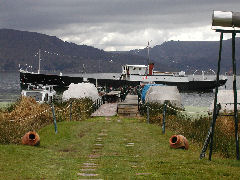 We thought we’d head for the Yavari, Puno's famed floating museum, written up in more places that I'd care to count. It's touted as an amazing naval museum, restaurant, café, and local hangout. Let's start with that the only person hanging out on the Yavari, which is indeed a boat, anchored behind a local hotel, is Carlos Saavedra, the boat's captain. He's charming, witty, and great entertainment, not to mention a font of information about local culture, dining, and, of course, his boat. He lives on it. No one else is hanging out there, though tourists do come by to see the place and take a tour with him (free, though donations are accepted via a discreet drop box. There's a galley where he prepares food for his evening dinner. No café, no restaurant. The hotel that the boat is anchored behind does have a restaurant. There's another boat from "the fleet" that's in drydock at the central port, being converted to a restaurant and café – it should be ready in a few years. [Note: Just spotted a note in the Peruvian Times that Carlos has retired as of March 2009.]
We thought we’d head for the Yavari, Puno's famed floating museum, written up in more places that I'd care to count. It's touted as an amazing naval museum, restaurant, café, and local hangout. Let's start with that the only person hanging out on the Yavari, which is indeed a boat, anchored behind a local hotel, is Carlos Saavedra, the boat's captain. He's charming, witty, and great entertainment, not to mention a font of information about local culture, dining, and, of course, his boat. He lives on it. No one else is hanging out there, though tourists do come by to see the place and take a tour with him (free, though donations are accepted via a discreet drop box. There's a galley where he prepares food for his evening dinner. No café, no restaurant. The hotel that the boat is anchored behind does have a restaurant. There's another boat from "the fleet" that's in drydock at the central port, being converted to a restaurant and café – it should be ready in a few years. [Note: Just spotted a note in the Peruvian Times that Carlos has retired as of March 2009.]
Carlos was delighted to find out about our interest in food, even if it overshadowed our interest in his engines and portholes, so to speak. He loves food, thinks of cooking as an art (that in his opinion ought only to be practiced by true artists, at least in a public place). He knew of a woman, Consuela, who used to run a local restaurant, and now runs a puertas cerradas much like ours, out of her home – more in the next post – and he set us up to have lunch with he and some friends for the next day…
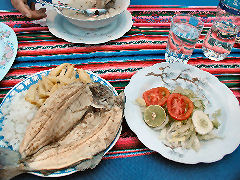 For this day, though, we headed back to the port where we’d been the day before. Two goals in mind – a bit of shopping in the artesanal market and lunch. The latter I can't make any great claims for. Henry went for a bowl of lamb soup – a tasty if slightly watery broth with a few pieces of lamb, a potato, and a carrot or two. I decided on the trout, which turned out to be not bad, especially considering it was one of the local lake trout that I mentioned in an earlier post – it still had that muddy flavor to it, though, not nearly as bad as the ceviche the other night, and cooked perfectly. It was accompanied by some salad and fries, and was fine for sitting out of doors at the port. That, and our entire lunch, including beverages, cost us a whopping eleven soles, or just over three dollars.
For this day, though, we headed back to the port where we’d been the day before. Two goals in mind – a bit of shopping in the artesanal market and lunch. The latter I can't make any great claims for. Henry went for a bowl of lamb soup – a tasty if slightly watery broth with a few pieces of lamb, a potato, and a carrot or two. I decided on the trout, which turned out to be not bad, especially considering it was one of the local lake trout that I mentioned in an earlier post – it still had that muddy flavor to it, though, not nearly as bad as the ceviche the other night, and cooked perfectly. It was accompanied by some salad and fries, and was fine for sitting out of doors at the port. That, and our entire lunch, including beverages, cost us a whopping eleven soles, or just over three dollars.
The afternoon was already planned as our next tour – we'd set it up with the same agency, Edgar Adventures – who, when we'd come back to enquire about additional tours, we're quite helpful, plus gave us a small discount on the normal twenty sole package. So, off to Sillustani, the tombs… I'm not sure what to say about them – it was a fascinating wander through the hills of the area, and our guide talked about the various pre-Incan and Incan cultures that had used the site for burial grounds, each of them building different styles of tombs. It's located atop a beautiful series of hills around a small lake that has a nature preserve on an island in the middle to preserve vicuna, a type of local deer, more or less, that has the unfortunate character of being one of the world's most sought after fur animals… We stopped on our way back at a small Aymara farm near to Sillustani to visit with the family, sample a little of their food (donations requested), be offered various handicrafts for sale, and tour their home. Interesting, if a bit commercialized.
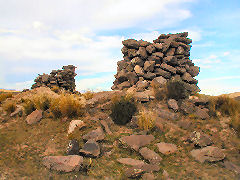
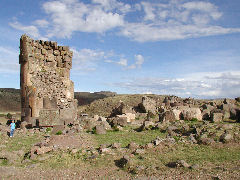
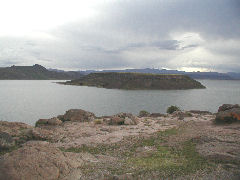
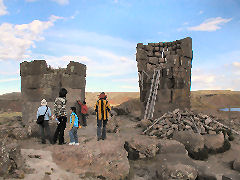
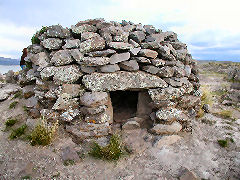
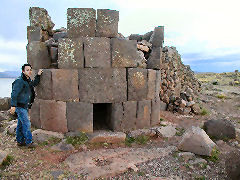

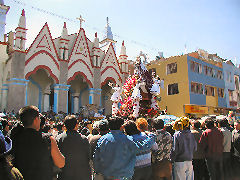 We arrived back in time to watch part of the Virgen de la Candelaria festival, this being the main day for the religious ceremonies – February 2nd each year. Yet one more procession wih a virgin up on the shoulders of the locals… Dinner was nondescript – we stopped at a local dive away from the center of town that was serving up a mix of Peruvian and Chinese cuisine – a bowl of chicken noodle soup, a chicken stir-fry, and a simple roast chicken with mashed potatoes.
We arrived back in time to watch part of the Virgen de la Candelaria festival, this being the main day for the religious ceremonies – February 2nd each year. Yet one more procession wih a virgin up on the shoulders of the locals… Dinner was nondescript – we stopped at a local dive away from the center of town that was serving up a mix of Peruvian and Chinese cuisine – a bowl of chicken noodle soup, a chicken stir-fry, and a simple roast chicken with mashed potatoes.